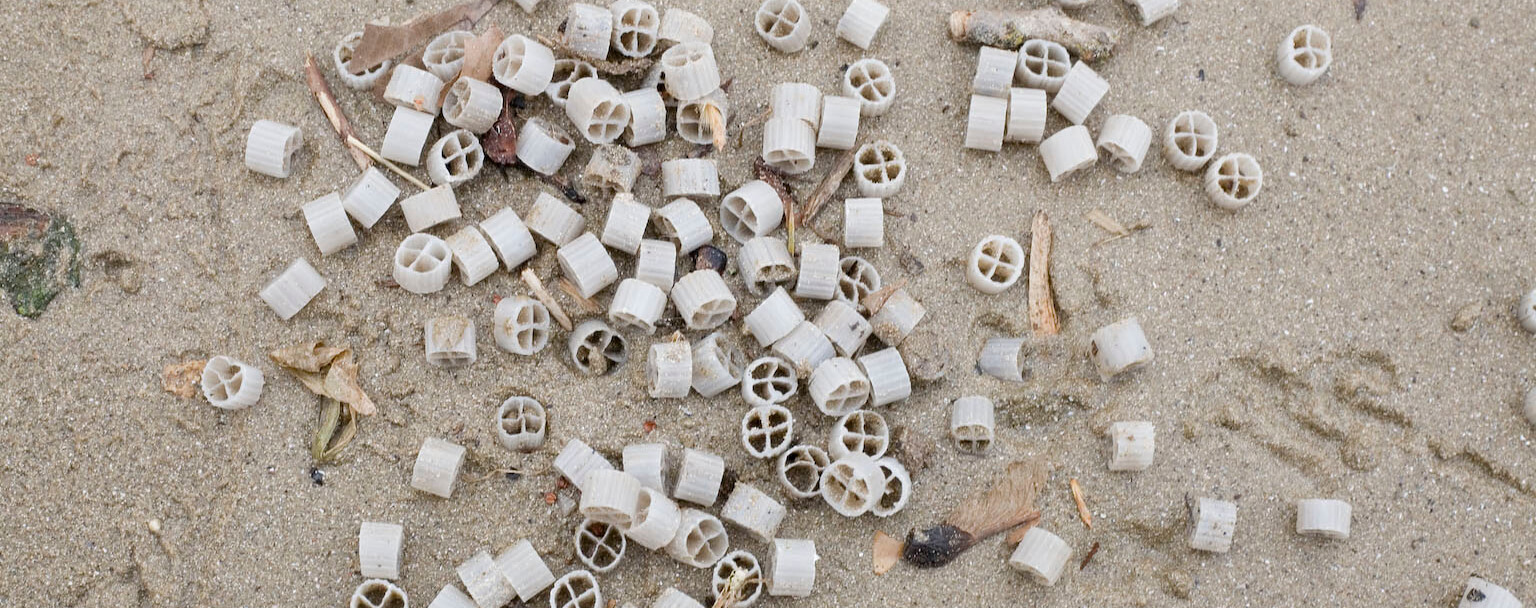If a lot is said about pellets, those small plastic beads that can be found in large quantities on beaches, there is another particularly concerning source of plastic pollution: biomedia.
These plastic rings are used in some wastewater treatment plants to attach purifying bacteria, but multiple incidents can lead to their leakage into the environment.


Biomedia pollution is concerning because it can:
- Be massive: A single treatment basin can contain hundreds of millions of biomedia. An accident can result in millions of these pieces leaking into natural environments.
- Be long-lasting: Most lost biomedia are never recovered.
- Spread over large distances: Biomedia can disperse over vast areas, crossing borders.
- Affect marine wildlife.
- Carry toxic pollutants: Designed to fix bacteria, biomedia can also serve as a substrate for other substances present in wastewater, such as fecal bacteria, viruses, industrial products, detergents, hydrocarbons, pesticides, cosmetics, and medication residues.
The latest pollution event occurred in Loire Atlantique at the end of 2023: thousands of biomedia were found on the beaches of Pornic, Saint-Brevin, and Saint-Nazaire. Observed by volunteers from the Surfrider Foundation, our association quickly sprang into action…
A REAL INVESTIGATIVE WORK TO FIGHT BIOMEDIA POLLUTION
It is estimated that an average of one major biomedia pollution event occurs per year.
For 15 years, Surfrider has been recording biomedia strandings reported by citizens. Thanks to these contributions, we have identified 40 cases of biomedia pollution across Europe out of the 1600 reports received. These reports are crucial for identifying and tracking affected areas.
Biomedia pollution cases are identified through several means:
- Citizens can report observed pollution directly on our website.
- During cleanups organized as part of Ocean Initiatives or following the OSPAR protocol.
- We work with other organizations and local authorities sensitized to this issue.
These various observation sources allow us to become aware of and, more importantly, track the evolution of pollution on riverbanks and European coasts.
When numerous reports come from the same area or a large quantity of biomedia is found, a major pollution event is suspected. We then switch to investigation mode. Given the speed at which biomedia disperse once in the environment, we must act quickly. To do this, we mobilize volunteers, citizens, and other local associations. The goal is to identify the source of the pollution so that measures can be quickly implemented to limit the extent of the pollution.
When we manage to identify the management structure of the faulty treatment plant, we initiate a dialogue phase by sending them our best practices guide to help implement corrective measures as quickly as possible. At the same time, public institutions responsible for monitoring treatment plants are also alerted so that administrative and technical follow-up can be carried out.
FROM INVESTIGATION TO THE EUROPEAN PARLIAMENT
Alongside field investigations, we continue to develop our knowledge on biomedia pollution by mapping the treatment plants that use them (over 250 in Europe) and gathering feedback from sanitation professionals. We have thus acquired real expertise on the subject.
At the European level, the data we have collected served as a reference for integrating specific measures aimed at preventing biomedia discharges into the environment in the new version of the Urban Waste Water Treatment Directive (UWWTD) and the second regional action plan on marine litter of the OSPAR Convention (RAP ML II).
In parallel, the association’s expertise on the subject led to it being commissioned in 2023 by the Swedish Environmental Protection Agency on behalf of the “Nordic Council of Ministers” to produce a best practices guide aimed at reducing the risk of biomedia loss.


2023 SUMMARY REPORT AND BEST PRACTICES GUIDE: TWO DOCUMENTS TO BETTER UNDERSTAND AND AVOID BIOMEDIA POLLUTION
In addition to investigations, our involvement in various working groups has allowed us to collect feedback from professionals and draft a complete report 📄 on the subject to assess the extent of the biomedia pollution phenomenon to date.
40 pollution cases have thus been studied. A wide variety of stakeholders—citizens, environmental protection NGOs, sanitation professionals, and municipalities—have contributed to this work, allowing for a better understanding of why these plastic biomedia end up on coasts.
The report highlights the impact of their dispersion in the natural environment following malfunctions of treatment plants, whether collective, industrial, or privately owned. It is the cornerstone of our approach to raising awareness among sanitation actors about biomedia pollution in Europe.
In addition to this report, we have worked on a best practices guide 📄 for sanitation professionals containing over 150 recommendations. It aims to limit biomedia loss in treatment plants by suggesting improvements in both administrative and technical aspects.
This document notably addresses:
- Preventing leaks by implementing physical barriers and capture systems to avoid biomedia dispersion.
- The necessity of maintenance and monitoring phases, including regular inspections and maintenance of installations to ensure their proper functioning.
- Improving the design of plants to minimize the risk of leaks.
- Training operators and raising stakeholder awareness about risks and best practices.
- Recommendations for setting up clear protocols for the rapid management of leaks and incidents.
Surfrider Foundation Europe continues to actively engage in the fight against biomedia pollution. However, to strengthen and adjust our recommendations, we are seeking pilot treatment plants willing to implement our best practices. These collaborations will allow us to evaluate the effectiveness of the proposed measures, adapt them if necessary, and further raise awareness among sanitation actors about this issue. Together, we can reduce the impact of biomedia and protect our aquatic environments for future generations.
At every stage of the biomedia lifecycle, solutions exist. They are sometimes inexpensive, and stakeholder awareness can significantly improve the management of this pollution.
4o

